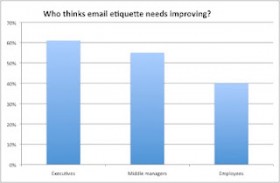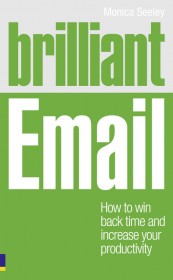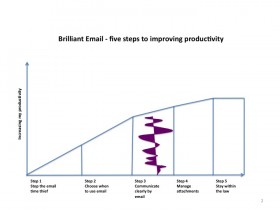Michael Einstein of Email Overload Solutions recently wrote about listening properly before replying. For us at Mesmo Consultancy this so resonated with all we say about think before hitting send we wanted to share it with you (and for which he gave us permission).
Listening is a critical part of communication. It is an activity many people take for granted yet perform quite poorly. Active listening can help greatly improve your communication with others.
It is very easy to “hear” but can be very difficult to actually “listen”. Have you ever found yourself planning a response to someone before they even finished speaking?
Has listening just become a game of waiting for the time for when someone stops speaking so that you can start talking yourself? This is where active listening can be improve your communication abilities. Stephen R. Covey, author of “The 7 Habits of Highly Effective People: Powerful Lessons in Personal Change”, wisely said:
“Most people do not listen with the intent to understand; they listen with the intent to reply”.
How many time have you hit send before you have really read and thought through what the sender is saying? Here are Mesmo Consultancy’s top five tips to improve your email listening and communication skills.

Email listening
Click here to check your personal email etiquette. For more help on listening well to improve business email communications contact us about our Brilliant Email workshops and masterclasses.
Tags: Business email communications, email communications, email etiquette, Listening, Michael Einstein, Quiet Email, Quite email, Slow email
In the final part of this series of interview with David Grossman, he reviews what are the barriers and drivers to creating a more effective email communications culture.
Monica: What do you see as the principle issues restricting the use of email within organizations?
David: Limiting email and reducing abuses is a step in the right direction, especially for middle managers.
We conducted research of 1,100 executives, senior leaders, managers, and employees on their perceptions of e-mail.
Our 2012 email perception study, “Enough Already! Stop Bad Email,” shows that when it comes to email overload, it’s the middle managers who feel the most pain:
And yet, they don’t want their ability to use email taken away or even interrupted. 83 percent of middle managers agree that email is an effective and necessary communication tool, and only 15 percent said that limiting email during normal business hours would be very effective. Our research suggests that to melt the iceberg that is the “Frozen Middle,” companies need to do a few things:
All that said, limiting email and stopping abuses isn’t the ultimate solution to improving employee engagement, work-life balance, and productivity. Really, it’s a Band-Aid because the much larger issue is about ineffective communications inside organizations today, which is negatively affecting business results. That means leadership needs to assess and improve the overall communication system for the organization.
Monica: How can we improve this situation – top three tips.
David:
For more information on email overload, its effects on the frozen middle, and additional tips, visit our Email Research and Resource Center.
David Grossman, ABC, APR, Fellow PRSA helps leaders drive productivity and get the results they want through authentic and courageous leadership communication, a sought-after speaker and advisor to Fortune 500 leaders. A two-time author, David is CEO of The Grossman Group, an award-winning Chicago-based strategic leadership development and internal communication consultancy; clients include: DuPont Pioneer, Lockheed Martin, McDonald’s, Motel 6 and Tyco, to name a few.
Tags: Clean Inbox, clean out your inbox week, corporate email etiquette, David Grossman, email communications, email overload, The Grossman Group
As part of the 7th International Clean Out Your Inbox Week, I was privileged to work with David Grossman CEO and founder of the Grossman Group leaders in strategic leadership and internal communication. This is the first of three discussions we had by a variety of media (phone, email etc).
Monica: Just how effective do you feel email is as a communications tool?
David: Email can be a highly effective communications tool, if used properly. That’s a big “if.” It’s a vehicle we love to hate, and many of us struggle with e-tiquette. Here are the most common abuses and bad habits that get in the way:
No wonder email gets a bad rap. Very few of us can say that we haven’t committed at least one of the sins above. We’re part of the problem, and also can be part of the solution.
The second interview reviews how we can make our email communications more effective and at the same time reduce the volume of email overload.
David Grossman, ABC, APR, Fellow PRSA helps leaders drive productivity and get the results they want through authentic and courageous leadership communication, a sought-after speaker and advisor to Fortune 500 leaders. A two-time author, David is CEO of The Grossman Group, an award-winning Chicago-based strategic leadership development and internal communication consultancy; clients include: DuPont Pioneer, Lockheed Martin, McDonald’s, Motel 6 and Tyco, to name a few.
Tags: Clean Inbox Week, clean out your inbox week, David Grossman, email communications, email overload, The Grossman Group
Last week it was the CBI report on the need to improve basic literacy skills which prompted my blog on the dire state of email etiquette. Simultaneously there was the excellent report ‘e-nough alre@dy from Grossman Group a leading American communications consultancy. It found that whilst email is perceived as a very effective communications tool many felt email communications needed improving. In particular email etiquette needed attention. The break down is shown below.

They key issues relating to email etiquette being:
This looks just like the list of challenges which we hear when running workshops and asking the question ‘what annoys you about email‘.
Are these results surprising when so few people have ever been trained to use email properly? What ever happened to all those workshops on letter writing which many of us who belong to Generation X had to attend?

‘The Debbrets handbook for email etiquette’ – Jerry Stimfig
Whilst many of us were used to writing social letters, once we started work it was off to learn about the principles of writing business letters.
Email has now become the business letter of the 21st century. Yet why are so few organisations reluctant to run email etiquette courses? Those that do are often shutting the stable door after the horse has bolted: their organisation has become part of the latest media disaster or emails are being used as evidence in court. Poor email etiquette can be very costly.
Budgets we know are tight and so at the very least you could provide your staff with a set of sound email etiquette guidelines. These should include:
Please feel free to use the Mesmo Consultancy ‘Email Etiquette Checklist’ posted in an earlier blog. Alternatively we would be more than happy to come and talk about our Brilliant Email Etiquette master classes and how these can help you save time and money.
Tags: corporate email etiquette, email communications, email etiquette dos and don'ts, email etiquette rules
 |
| From Brilliant Email by Monica Seeley, Pearson, 2010 |
Can email etiquette help stop email overload and enable you to reach inbox zero status? In my book Brilliant Email, email etiquette is identified as step 3 for improving productivity – see diagram opposite.
Like any form of communication, it is about conveying the right message right first time and know when to stop the conversation and move on. In a previous blog I wrote about the importance of good grammar and spelling.
How often in an email do we leave ourselves open for the recipient to send a reply which adds little or nothing to the communication but means that out of courtesy we must reply again?
Take a look at the email chains in your inbox and I’ll bet you have quite a few which could have been terminated much earlier. For example, when you ask someone for information, to do something etc. There are often two or three quite unnecessary rounds of email ping pong as you each play what I call the ’email thank you game’.
Recipient – Yes OK will do.
Sender – Thank you.
Recipient – That’s OK.
Sender – By the way can it be done by 12.00 noon?
Recipient – Yes.
Sender – Thanks.
Etiquette suggest that we say thank you. But how about using brilliant email etiquette to reduce the number of rounds of the email thank you game and hence stop email overload.
Here is what I would say in my email as the sender.
Sender – Please can you do X and if possible by noon today. Many thanks for your help.
Recipient – Yes.
End of the email chain and a chance to reach inbox zero status more quickly.
For more ways to save time and reduce email overload by using an alternative medium why not come on one of our Brilliant Email masterclasses or webinars?
What email etiquette do you use to be courteous yet reduce the rounds of the email thank you game?
Tags: email communications, email etiquette, email overload, inbox zero